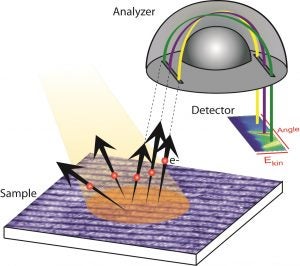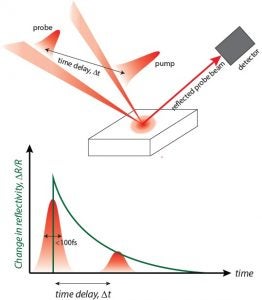Angle-resolved photoemission spectroscopy (ARPES)
ARPES is a powerful experimental technique for measuring the bulk and surface electronic structure of crystalline solids in momentum space. Coupled with theory, this technique can elucidate Fermi surfaces and band dispersions of new materials, quantify the magnitude and momentum dependence of spectral gaps which are related to the order parameter of many types of emergent phases, and reveal effects of strong coupling of electrons to other electrons and to bosonic excitations.

ARPES is based on the photoelectric effect, for which Einstein received his Nobel prize. UV light shines on a sample, and electrons are photoemitted from the sample surface. When these electrons are photoemitted, they still carry information about how they were moving back inside the sample, except they received a (known) energy kick from the photons. The momentum imparted by the photons is negligible at the wavelengths used in most experiments. By precisely measuring the kinetic energy and emission angle of photoelectrons, one can construct their energy vs momentum relationship (dispersion relation or band structure) of electrons inside the sample.
Ultrafast optics
Ultrafast spectroscopies use sub-picosecond laser pulses to manipulate and investigate quantum materials on nanosecond, picosecond, and sub-picosecond timescales characteristic of many key interactions in these systems. My group does pump-probe experiments: first, a pump pulse of light excites (usually) electrons out of equilibrium, and then, after a short time delay, a probe pulse studies how the system has responded. Our experiments measure transient reflectivity (change in reflectivity of the probe pulse) as a proxy for how the electronic system returns to equilibrium. This is a very versatile experiment that can be applied to almost any sample without stringent requirements for size, thickness, or surface quality. We typically employ these experiments in conjunction with ARPES studies for two complementary views of low-energy excitations–in the time domain and in the energy and momentum domain.
